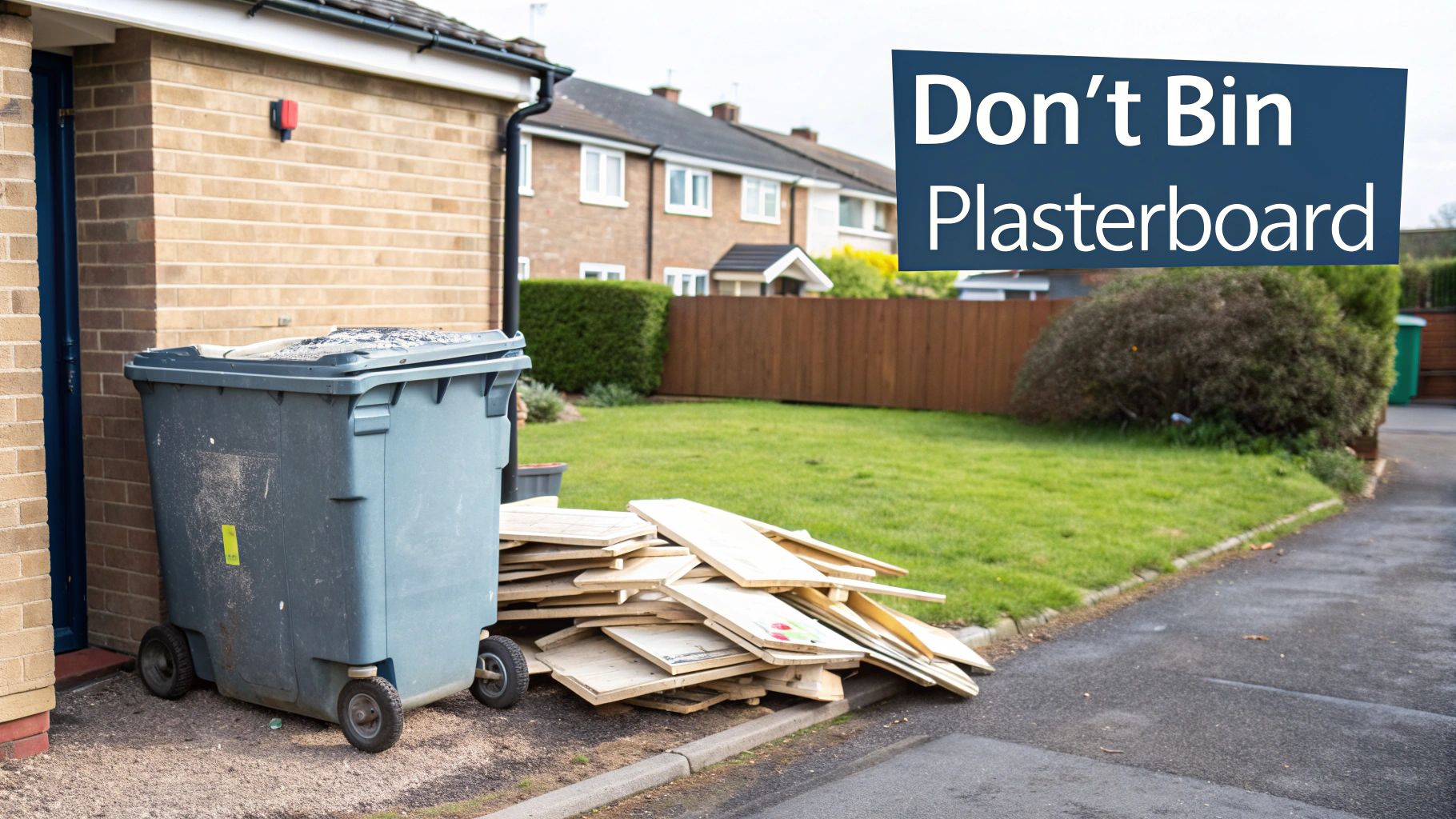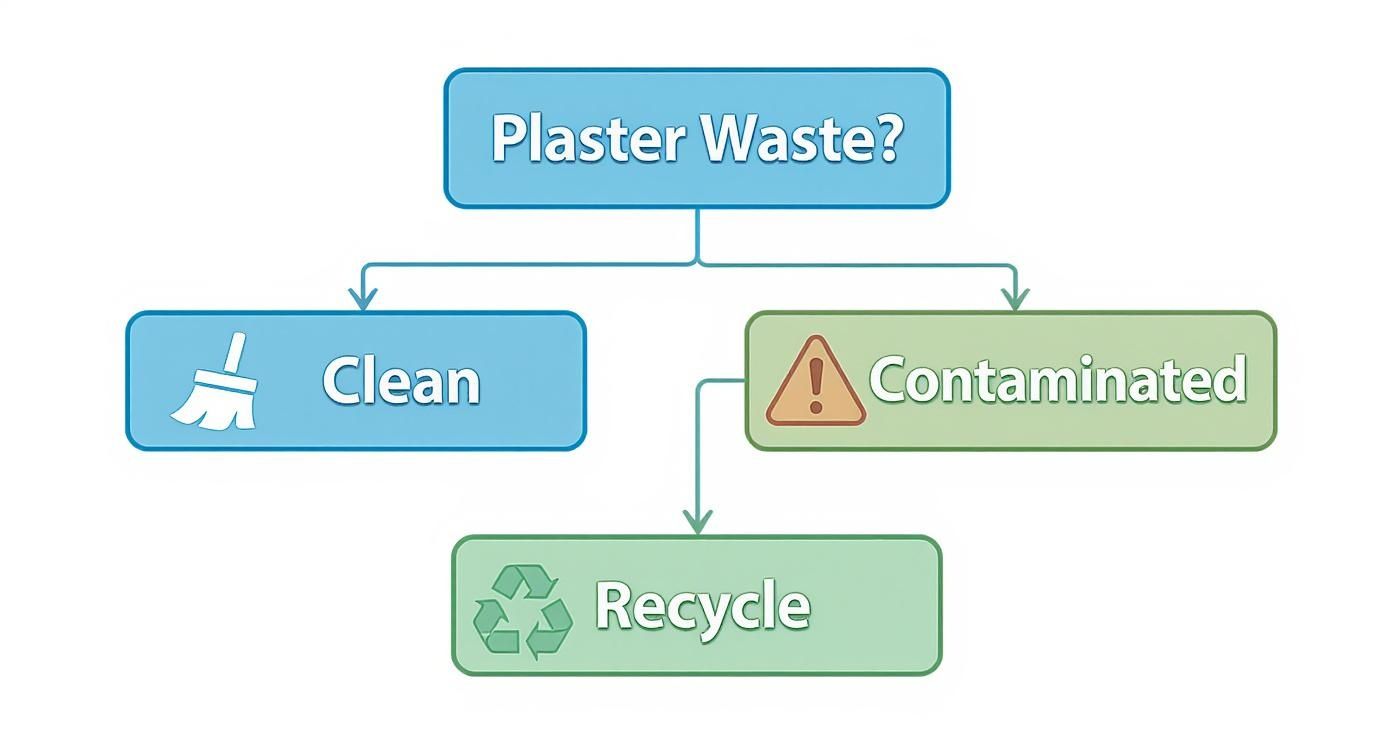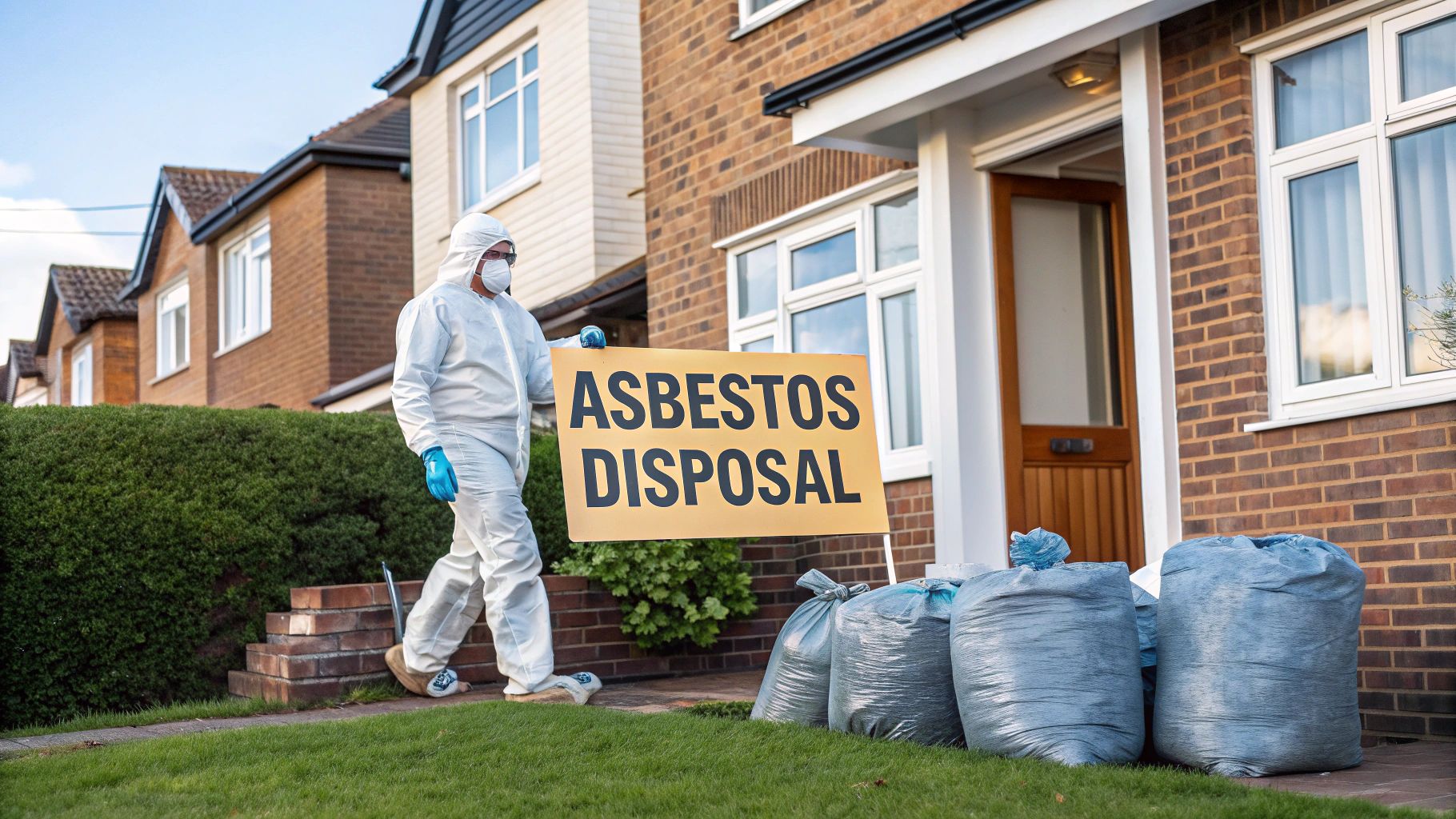A Practical Guide to Disposal of Plaster
A Practical Guide to Disposal of Plaster
It might seem like the easiest thing in the world to toss a few plasterboard offcuts into a general waste skip, but when it comes to the disposal of plaster, you need to handle things a bit differently. Gypsum-based materials like plaster are actually banned from standard landfills because when they mix with other waste, they can release toxic gas. Getting this right isn't just about being environmentally friendly; it's a legal requirement.
Why You Can't Just Bin Plasterboard

It comes as a surprise to many, but plasterboard is classed as hazardous when it’s mixed in with your regular rubbish. This isn't because the material itself is dangerous on its own, but because of a chemical reaction that happens under landfill conditions.
The core of plasterboard is made of gypsum, which is a sulphate-based mineral. When it gets wet and starts to break down in an oxygen-poor environment alongside biodegradable waste (think food scraps or garden cuttings), it can produce hydrogen sulphide gas. This gas is nasty stuff – it has that foul "rotten eggs" smell, and it's also flammable and toxic.
The Legal Duty of Care
To stop this from happening, UK regulations are very clear. The Environment Agency insists that gypsum-based materials must be kept separate from other waste. This 'duty of care' isn't just for big construction firms on massive projects; it applies to everyone, right down to homeowners tackling a small DIY renovation.
This legal responsibility means you can't just try to hide plasterboard at the bottom of a mixed-waste skip. Waste transfer stations are on the lookout, and if they find plaster, the entire load can be rejected. That can lead to some unexpected costs and frustrating delays. You can get the full story on the specific reasons why you can't put plasterboard in skips in our detailed guide.
With the amount of construction going on, the responsibility on all of us is greater than ever. Failing to segregate plasterboard isn't just bad practice; it's a breach of your legal duty of care, which can result in significant fines.
A Growing Waste Challenge
The challenge of managing plaster waste is only getting bigger. Between 1997 and 2019, plasterboard waste in the UK more than doubled, hitting volumes of over 300,000 tonnes by the end of that period, thanks to new housing and changing trends.
These figures really highlight just how critical it is to have effective recycling and waste management strategies in place. Understanding the rules is the first step towards getting rid of your plaster properly and responsibly.
Keeping Your Plaster Waste Clean from the Start
Thinking about how you’ll get rid of plaster waste shouldn’t be an afterthought. Proper disposal starts the second you create the mess, and the golden rule here is simple: segregation.
Keeping plaster and plasterboard completely separate from all other types of construction waste is absolutely non-negotiable if you want to dispose of it legally and sustainably.
For a small DIY job, this could be as straightforward as having a few dedicated, heavy-duty rubble sacks set aside just for plaster. Get a marker pen and label them clearly so nothing else gets mixed in by accident. On a bigger job, you’ll often see professionals designating a specific corner of a room, or an area right next to their main skip, purely for plasterboard offcuts and waste.
This one simple habit prevents cross-contamination, which is the single biggest hurdle to getting plaster recycled.
What About Contaminated Plaster?
Of course, not all plaster waste is clean. The real challenge pops up when you're dealing with contaminated materials. This is anything from plasterboard with tiles still stuck to it, sections covered in stubborn wallpaper, or boards that have been heavily painted or skimmed with a non-gypsum material.
These extra bits and pieces can really throw a spanner in the works for recycling facilities. Ceramic tiles and their adhesives, for instance, can’t be easily separated from the gypsum core. Certain paints might also contain chemicals that would render the final recycled product completely unusable.
Here’s a simple rule of thumb to keep in your head on site: if it isn't just plasterboard, it's contaminated. This mindset helps you make quick, smart sorting decisions and stops an entire batch of otherwise good plaster from being rejected at the recycling plant.
So, what are your options when you’ve got the contaminated stuff?
- Scrape Off What You Can: If it’s practical, take a moment to remove surface-level contaminants like old wallpaper or loose tiles before you bag it up.
- Have an Honest Chat with Your Waste Carrier: Don't try to hide it. Be upfront about any contamination. Some facilities are equipped to handle minimal amounts, while others will tell you it needs to be disposed of as general (non-hazardous) waste instead.
- Keep It Separate Anyway: Even your contaminated plaster should be kept apart from the clean plasterboard. This ensures you can still recycle the maximum amount possible from your project.
By sorting your plaster waste properly from the get-go, you’re making the entire disposal process smoother, more cost-effective, and a whole lot kinder to the environment.
Choosing Your Plaster Disposal Method
Once your plaster waste is neatly separated, it’s time to work out where it’s going to go. Figuring out the best disposal route can feel a bit complicated, but getting to grips with your options will help you make a smart choice that’s both compliant and cost-effective. Ultimately, the right method boils down to the amount of plaster you’ve got, your budget, and how much of the work you want to do yourself.
The very first decision point is a simple one: is your plaster waste clean or is it mixed with other rubbish? This is the crucial first step in deciding its fate.

As you can see, if the waste is clean and uncontaminated, the best path forward is recycling. It’s the most sustainable option and feeds back into a circular economy.
Visiting Your Local HWRC
For smaller DIY jobs, heading to your local Household Waste Recycling Centre (HWRC) is often the most straightforward choice. These centres, which you might just call 'the tip', are set up to take specific types of waste that can't go in your regular household bins, and that includes plaster and plasterboard.
Before you load up the car, though, make sure you check the rules. Many HWRCs put limits on how much construction waste they’ll accept for free in one go or over a certain period. Go over that limit, and you could face charges. These centres are a huge part of the UK's waste strategy; back in 2021, there were 1,025 HWRCs serving over 28 million households, playing a massive part in keeping materials like plaster out of landfill.
A quick tip from experience: always check your local council's website before you set off. You might need to book a slot, and they’ll list any specific rules or fees for DIY waste. A five-minute check can save you a completely wasted trip.
Hiring a Plasterboard Skip or Collection Service
If you’re tackling a bigger renovation that’s generating a serious amount of plaster, hiring a dedicated skip is a much more practical solution. It means all your plaster waste is contained in one place and dealt with correctly by a licensed waste carrier. The main benefit here is pure convenience—the waste is just taken away, and all the important legal paperwork is handled for you.
For a deeper dive into this option, have a read of our guide on how to correctly dispose of plasterboard.
Another great option, especially for larger volumes from renovations, is to look into local house clearance and rubbish removal services. They can often provide a more flexible 'man and van' style collection.
No matter which professional service you choose, there are a few non-negotiables to look for:
- A Valid Waste Carrier Licence: This is absolutely essential. Don't be afraid to ask for their licence number and check it on the Environment Agency's public register.
- Clear Segregation Rules: A reputable company will be strict about the skip being used only for plaster and plasterboard. Any contamination with other waste could mean they refuse to take the load.
- A Waste Transfer Note: When they collect the waste, you must be given this document. It’s your legal proof that you’ve handed your waste over to a licensed carrier to be disposed of properly.
Comparing Plaster Disposal Methods
To make things a bit clearer, we've put together a simple table comparing the main disposal options. This should help you weigh up the pros and cons based on your specific project.
| Disposal Method | Best For | Typical Cost | Key Considerations |
|---|---|---|---|
| Local HWRC (Tip) | Small DIY projects with minimal waste | Free (up to council limits) | You'll need to transport it yourself. Check for quantity limits and booking requirements. |
| Dedicated Plasterboard Skip Hire | Large renovations, construction projects | Varies by size and location (£150 – £300+) | Extremely convenient for large volumes. Ensures proper segregation and legal disposal. |
| 'Man and Van' Rubbish Removal | Medium-sized projects, quick clear-ups | Priced on volume (e.g., £70+ per cubic yard) | Flexible and they do the loading. Good for when you can't have a skip on-site. |
| Plasterboard Recycling Collection Services | Businesses and large-scale producers | Often charged per bag or tonne | The most sustainable option, ensures material is fully recycled. |
Choosing the right method isn't just about cost; it's about making sure your waste is handled legally and responsibly. Taking a moment to consider these options will ensure your project runs smoothly from start to finish.
The Bigger Picture of Gypsum Recycling

Choosing the right disposal route for your plaster isn't just about ticking a box or following the rules. It's about playing your part in a much smarter, more sustainable system known as the circular economy. Instead of the old-school "take-make-dispose" approach, this system is all about reusing and recycling materials, giving them a second, third, or even fourth life.
When you make the effort to send clean plasterboard for recycling, you’re not just keeping it out of a landfill. You’re starting it on a remarkable new journey.
From Old Board to New Product
Specialist recycling facilities take your old plasterboard and put it through a clever process. First, the boards are crushed up, and the paper lining is stripped away. What’s left behind is high-purity gypsum powder—the very same raw material used to make brand-new plasterboard.
This creates a fantastic closed-loop system where old drywall literally becomes new drywall. It’s a game-changer that massively cuts down on the need to mine for virgin gypsum.
But its new life doesn't always have to be as plasterboard. That recycled gypsum has some other surprisingly valuable uses.
- Agricultural Soil Conditioner: Farmers and gardeners use gypsum to improve the structure of their soil. It's brilliant for breaking up heavy clay, allowing water and roots to get in more easily. It also adds vital nutrients like calcium and sulphur.
- Cement Production: Gypsum is also a key ingredient in making cement. It acts as a setting retarder, which helps to control the pace at which concrete hardens.
By choosing to recycle, you directly support these industries and ensure a valuable natural resource isn't just buried and forgotten. Your small renovation project suddenly has a much bigger, positive impact.
Supporting National Sustainability Goals
Every small action feeds into a much larger national effort. Waste treatment trends show the UK’s overall recycling rates have climbed impressively, hitting about 44% in 2021—a huge jump from just 11% back in 2000. While plaster recycling still has its challenges, every correctly segregated load you send contributes to this positive momentum.
Understanding how to recycle plaster properly is a key part of this. And if you're interested in the wider world of environmentally responsible construction, it's worth reading up on sustainable building practices. Every little choice helps to build a less wasteful future.
Common Plaster Disposal Mistakes to Avoid
Learning from other people's mistakes is often the fastest route to getting things right. When you're dealing with plaster disposal, a few common slip-ups can lead to major headaches, from a skip company rejecting your entire load to hefty fines landing on your doorstep.
Probably the most frequent error we see is people mixing plasterboard into a general waste skip. Just picture it: you've finally finished a big renovation, the skip is full, but the waste carrier refuses to take it because a few offcuts are buried inside. It happens all the time. Suddenly you’re facing project delays and potentially paying twice just to get the waste sorted and taken away properly.
Another absolute no-go is thinking you can burn old plasterboard. This isn't just a bad idea; it's incredibly dangerous. When gypsum burns, it lets off toxic sulphur dioxide, a nasty pollutant that causes serious irritation to your lungs. On top of being a health hazard, it’s illegal and completely useless for getting rid of the stuff.
Dodging Illegal Disposal Routes
Finally, and this one is crucial, be extremely wary of unlicensed waste carriers. That cheap 'man with a van' you found online might seem like a bargain at first, but it's a common front for illegal fly-tipping.
If your waste gets dumped illegally and it can be traced back to you, the responsibility is still yours. You could be facing a significant fine, even though you paid someone else to handle it. Always, always ask to see a valid Waste Carrier Licence.
Avoiding these common pitfalls is actually pretty straightforward. Just stick to these rules:
- Always segregate: Keep your plaster and plasterboard waste completely separate from everything else. No exceptions.
- Never burn it: It's dangerous, bad for the environment, and against the law.
- Verify your carrier: Only use licensed professionals and make sure you get a Waste Transfer Note as proof of proper disposal.
Your Plaster Disposal Questions Answered
Even with the best plan, you often run into specific questions when you're actually faced with a pile of plaster waste. To help clear up any confusion, let's tackle some of the most common queries we get about getting rid of plaster.
Can I Just Put Small Bits of Plaster in My Household Bin?
In a word: no. You should never, ever put plaster or plasterboard into your general household waste, no matter how small the amount.
This isn't just a guideline; gypsum-based materials are specifically banned from being mixed with regular biodegradable rubbish in UK landfills. Why? Because this mixture can create hydrogen sulphide – a seriously toxic and smelly gas.
Even a handful of offcuts needs to be handled properly. Your only real options are to take it to your local Household Waste Recycling Centre (HWRC) or arrange a collection with a licensed waste carrier. A quick look at your local council's website will tell you exactly what their rules are.
What’s the Difference Between Disposing of Wet and Dry Plaster?
Because both wet, unused plaster and dry plasterboard offcuts are gypsum-based, the disposal rules are pretty much the same. The real difference is in how you handle them. Dry offcuts are easy enough to bag up and set aside for recycling. Wet plaster, on the other hand, is heavy, messy, and needs careful management.
The most important thing to remember is to let any leftover wet plaster harden completely before you even think about moving it. And whatever you do, never wash it down a drain or sink. It will set solid and cause a nightmare blockage that’s incredibly difficult to fix.
Once it's fully hardened, you can treat it just like any other piece of plaster waste.
A Waste Transfer Note (WTN) is the legal paperwork you need for any load of commercial waste that changes hands. It’s your proof that you’ve disposed of your waste correctly and legally.
Homeowners taking their own DIY waste to a recycling centre won't need a WTN. But if you hire a skip or a collection service for your plaster waste, the company must give you one. It's a non-negotiable part of the process.
For hassle-free, fully compliant plaster disposal in Dorset, you can always trust the experts at The Waste Group. We provide dedicated skip hire and collection services to manage your waste responsibly and sustainably. Find out more and get a quote today.



